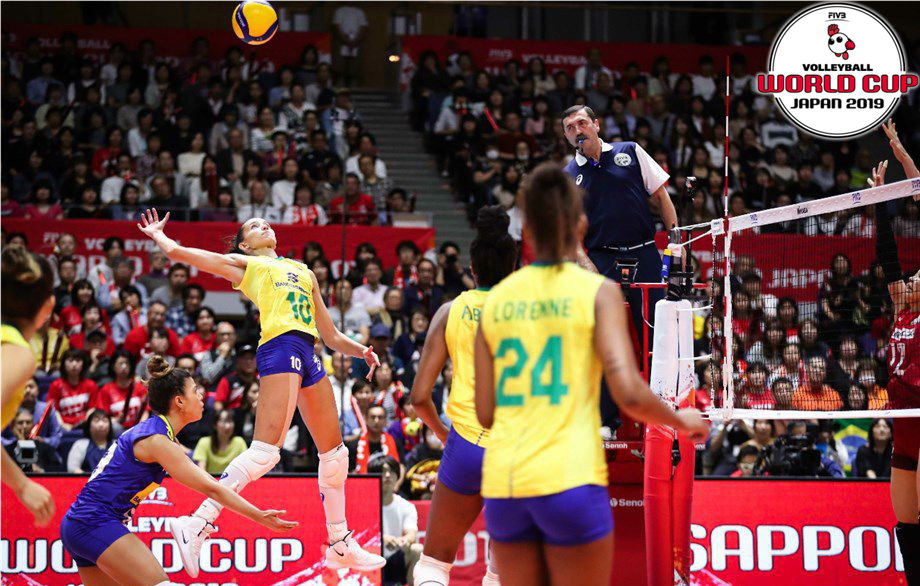The 2019 FIVB Volleyball Women’s World Cup was the thirteenth stage of the FIVB Volleyball Women’s World Cup, contested by senior women’s national teams of members of the Fédération Internationale de Volleyball (FIVB), the sport’s world governing body. The tournament was held in Japan from 14 to 29 September 2019. Japan hosted the event for the twelfth time in a row. This was the first time the FIVB did not distribute venues for the Olympics since 1991 due to Japan hosting the Olympics in 2020, but points for the FIVB World Rankings were awarded.
China won its historic fifth title, after titles in 1981, 1985, 2003, and 2015. China surpassed Cuba’s previous record of four titles in the competition’s history. Defending their title as reigning champions in 2015, China reigned to sweep all eleven matches in Yokohama, Sapporo, and Osaka. The United States and Russia complete the 2019 podium as silver medalists and bronze medalists, respectively.
Zhu Ting, attacker and captain of China’s women’s national volleyball team, was selected as the World Cup MVP, retaining her 2015 title. Zhu was joined in the Dream Team by three members of the gold medal-winning Chinese team. – Yan Ni as best centre-back, Wang Mengjie as best libero and Ding Xia as best shipowner. Two members of Team USA Who finished second after the Chinese team were also part of the Dream Team, as Kelsey Robinson and Andrea Drews won the awards for Best External Attacker and Best Opposite, respectively. Irina Koroleva of Russia also won as Best Blocker.
Table of Contents
Qualification
Twelve teams qualified for the competition as the top two FIVB World Rankings teams from each continental federation on January 1, 2019 (except Japan, which qualified as host, and Serbia, which qualified as 2018 World Champion).
Qualified teams
Country Confederation Qualified as Qualified in Previous Appearances
Total First Last
Japan AVC Host Country January 31, 2013, 12 1973 2015
Serbia CEV World Champions 20 October 2018 3 2007 2015
porcelain AVC AVC World Ranking January 1, 2019, 10 1977 2015
South Korea 12 1973 2015
Cameroon CAVB CAVB World Ranking 0 – –
Kenya 5 1991 2015
Russia 1 CEV CEV World Ranking 8 1973 2015
Netherlands 1 1995 1995
Brazil CSV World Ranking of CSV 9 1973 2011
Argentina 5 1973 2015
United States NORCECA NORCECA World Ranking 10 1973 2015
Dominican Republic 4 2003 2015
Notes
1. Competed as the Soviet Union from 1973 to 1991; the Third appearance as Russia.
Squadrons
Coaches
Oldest coach: José Roberto Guimarães – 65 years and 44 days in the first match against Serbia.
Youngest coach: Jamie Morrison – 38 years and 306 days in the first game against Argentina.
Gamblers
Appearance record: Fabiana Claudino, Priscilla Altagracia Rivera Brens, Janet Wanja, Mercy Moim, and Kim Yeon-young he participated in the World Cup four times.
- Oldest Player: At 38 years and 38 days, Annerys Vargas is the oldest player to be nominated in the tournament.
- Youngest player: Bojana Gočanin is the youngest player at 16 years and 354 days.
- Tallest player: 2.01 m, Yuan Xinyue, and Brayelin Martinez are the tallest players ever nominated in the tournament.
- Shortest player: At 1.60 m, Léia Silva is the smallest player ever nominated in the tournament.
Format
The 2019 World Cup competition system was the only Round-Robin system. Each team played once against each of the remaining 11 teams.
The teams were divided into 2 groups of 6 teams each. In round 1, totaling 30 matches in 5 days, each team played against the other teams in the same group. For rounds 2 and 3, a total of 36 matches in 6 days, each team played against teams from another group.
The numbers in parentheses denote the FIVB World Rankings as of January 1, 2019, except for the hosts who took sixth place.
Standing procedure in the swimming pool
1. Total number of wins (matches won, matches lost)
2. In case of a tie, the following first tiebreaker will apply: The teams will be classified according to the most points won per match as follows:
- Match won 3-0 or 3-1: 3 points for the winner, 0 points for the loser
- Match won 3-2: 2 points for the winner, 1 point for the loser
- Match lost: 3 points for the winner, 0 points (0-25, 0-25, 0-25) for the loser
3. If the teams remain tied after examining the number of wins and points earned, the FIVB will examine the results to break the tie in the following order:
- Set quotient: If two or more teams are tied on the number of points won, they will be ranked by the quotient resulting from the division of the number of all sets won by the number of all sets lost.
- Points quotient: if the tie persists based on the established quotient, the teams will be classified by the quotient resulting from the division of all the points scored by the total points lost during all the sets.
- If the tie persists according to the points quotient, the tie will be broken according to the team that won the Round Robin match between the tied teams. When the tie in the points quotient is between three or more teams, these teams are ranked taking into consideration only the matches involving the teams in question.
Statistical leaders
The statistics for each group follow the reports vis P2 and P3. Statistics include 6 volleyball skills; serve, receive, put, prick, block and dig. The table below shows the top 5 ranked players in each skill plus the top scorers as of September 29, 2019.
Top scorers
The best scorers are determined by the points scored from attack, blocking, and service.

Leave a Reply
You must be logged in to post a comment.